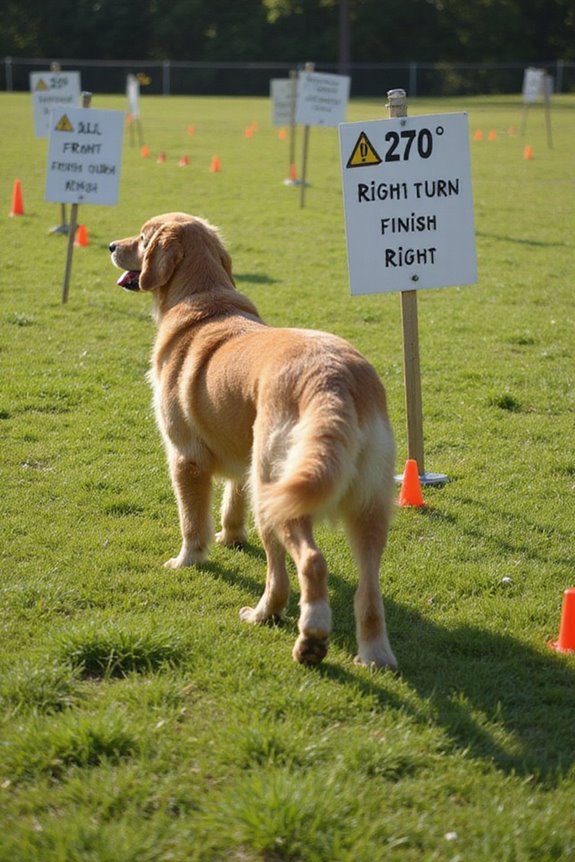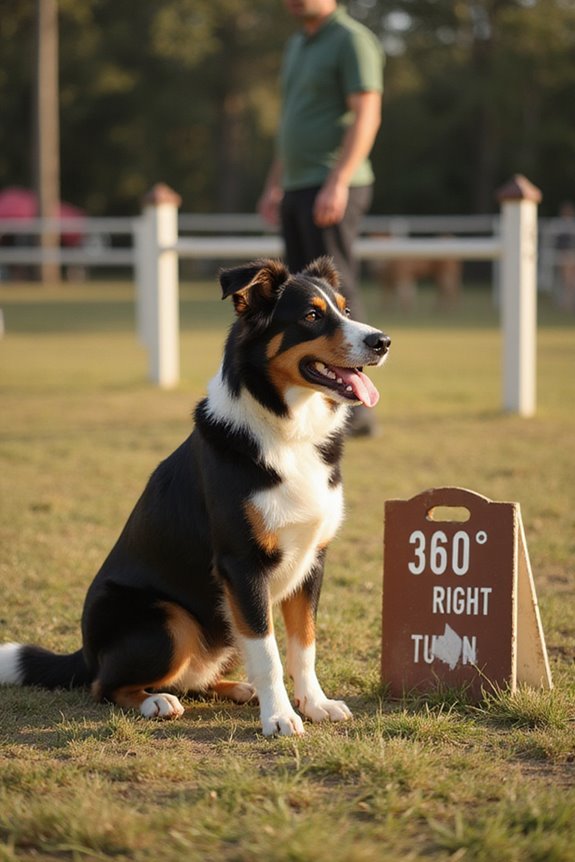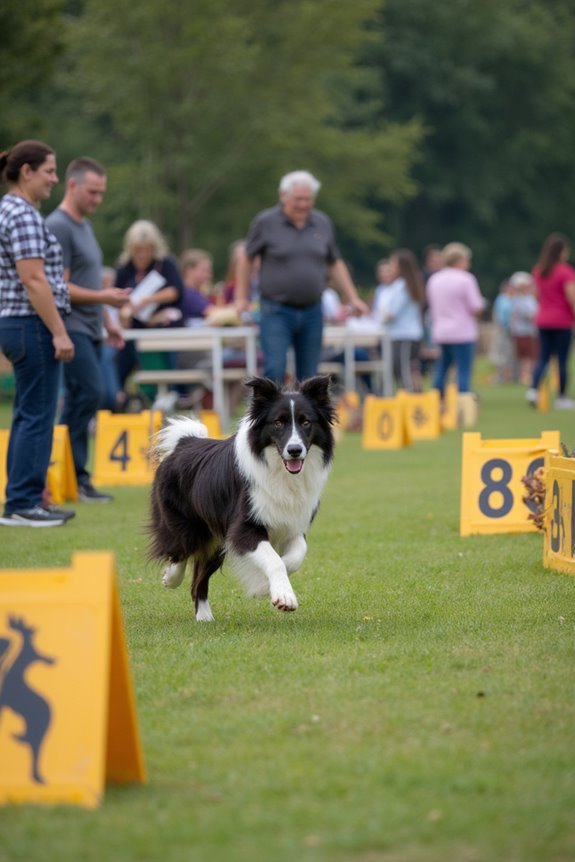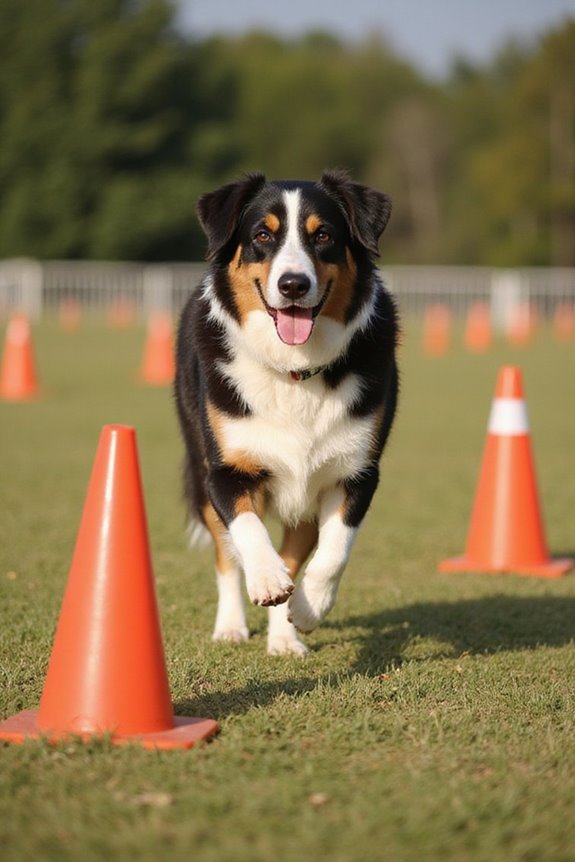Rally obedience competition is a structured dog sport that focuses on the teamwork between handlers and their dogs. In this competition, teams navigate a course marked by numbered signs, each indicating specific obedience exercises. Typically, the course consists of 10 to 20 different stations, requiring precise movements and basic commands. Points are awarded based on performance, with starting scores set at 200. This engaging challenge not only tests skills but also fosters a strong bond between the dog and handler as you progress together.
Key Takeaways
- Rally obedience competition, or Rally-O, involves navigating a course with numbered signs requiring specific obedience tasks.
- Dogs and handlers must demonstrate teamwork through precise movements and execution of exercises.
- The course layout features 10 to 20 exercise signs, with pathways marked by cones spaced 6 to 8 feet apart.
- Each team starts with 200 points, with scores adjusted based on performance for rankings and titles.
- Competitions are regulated by organizations like the AKC and WCRL, ensuring fair standards and licensing for clubs.
Definition and Concept of Rally Obedience
Rally obedience, often referred to as Rally-O, is an engaging dog sport founded on the principles of obedience. With roots in traditional obedience, Rally-O focuses on a sequence of exercises known as “doodling.” The sport emphasizes dog teamwork, as handlers and dogs navigate a course made up of 10 to 20 signs, each instructing specific obedience tasks. This dynamic activity encourages continuous communication and connection, unlike the rigidity often found in traditional obedience competitions. Rally history showcases its evolution, aiming to create an accessible and enjoyable experience for novice trainers. Fundamentally, it’s a vibrant blend of skill, joy, and partnership, highlighting the bond between handler and dog in a more interactive setting.
Structure and Layout of Rally Courses

Have you ever wondered how the structure of a rally obedience course can influence a team’s performance? The course design typically consists of a series of numbered signs, each specifying a skill exercise at various stations. The layout features cones marking the pathway, generally spaced 6 to 8 feet apart. Depending on competition level, the course length and number of stations can vary, with beginner courses being shorter.
Key components include:
- Station Execution: Each station necessitates precise movements, from heeling patterns to recalls, emphasizing teamwork between handler and dog.
- Angled Arrangements: Exercises may be positioned parallel, perpendicular, or diagonal to the path, enhancing the challenge.
Ultimately, successful navigation relies on adhering to the course map and maintaining fluid shifts.
Rules and Regulations Governing Competitions

Understanding the rules and regulations governing rally obedience competitions is essential for both competitors and organizers, as compliance guarantees a fair and efficient environment for all participants.
Entry Conditions:
- Open to all dog breeds, excluding specialty events.
- Judges’ dogs are not eligible to maintain fairness.
- Clubs must be approved to conduct official trials.
Scoring System:
- Each team begins with 200 points, with potential bonuses bringing scores to 210.
- Points are deducted for faults, impacting final scores.
- High scores determine qualifying runs, placements, and titles.
Prior to events, judges conduct briefings and setup procedures, ensuring clarity for all teams. Following these guidelines is not just recommended; it’s vital for a successful competition experience. Attention to detail creates a strong foundation for everyone involved.
Sanctioning Organizations and Their Roles

As competitors and organizers navigate the requirements of rally obedience competitions, the role of sanctioning organizations becomes increasingly apparent. These organizations, like the American Kennel Club (AKC) and World Cynosport Rally (WCRL), establish the rules and standards that govern our beloved sport. They provide several sanctioning benefits, including:
- Licensing requirements for clubs to hold official trials.
- Title and ranking systems for competitors based on performance.
Additionally, they offer resources and training materials to help participants thrive. Each organization has its unique guidelines, contributing to a diverse competitive environment. By ensuring compliance with regulations, sanctioning bodies maintain the integrity and consistency necessary for the rally experience, giving us a platform to showcase our skills and passion for our canine companions.
Essential Training Techniques and Skills

To excel in rally obedience competitions, it’s vital to adopt effective training techniques and develop a solid foundation of skills. Here are key components:
- Heel Position: Train your dog to walk closely by your left side, maintaining that heel position. Start off-leash to build confidence, using treats as positive reinforcement to encourage adherence.
- Basic Obedience Commands: Master essential commands like sit, down, stay, and come. Use marker training and luring for effective reinforcement without harsh corrections.
- Communication: Employ clear verbal cues and hand signals without physical contact, fostering a ‘conversation’ style for smooth handling.
- Advanced Skills: Gradually introduce distractions and complex cues, practicing in various environments. Consistent practice will enhance your teamwork and guarantee your dog responds reliably under competition conditions.
The Rally Competition Experience
Participating in a rally obedience competition can be a rewarding experience, especially when both you and your dog are well-prepared. The event’s structure includes a course with numbered signs indicating specific exercises. Ensuring handler engagement is essential; we can praise and encourage our dogs throughout the run, enhancing their motivation.
Before the trial, we have the opportunity to warm up in a designated area, reducing anxiety and fostering focus. Judges evaluate our performance based on accuracy and teamwork, with points deducted for faults such as missed stations. The atmosphere is supportive, allowing us to train our dogs under pressure while establishing a connection that showcases their responsiveness. These competitions cater to various skill levels, making it inclusive for all participants.
The Appeal of Rally Obedience for Dogs and Handlers
Rally obedience offers numerous advantages for both dogs and handlers, enhancing their connection in a structured, engaging environment. The bonding benefits of participating in Rally are profound, as we collaborate closely, fostering trust and communication. It promotes mutual understanding through shared tasks, improving not just our skills but also our relationship.
Moreover, the sport emphasizes stress reduction for both parties, creating a positive atmosphere filled with encouragement and rewards. Dogs thrive on the mental challenges presented by diverse stations, while handlers gain confidence through progressive practice.
Ultimately, Rally serves as an ideal platform, accommodating various skill levels and ensuring each team member can enjoy the journey, making lasting memories together.
Frequently Asked Questions
Can Rally Obedience Competitions Be Held Indoors or Outdoors?
Absolutely, I’ve seen rally obedience competitions held in both indoor settings and outdoor environments. Each offers unique advantages, and it’s exciting to participate regardless of the venue—whether we’re inside enjoying comfort or outside embracing nature’s beauty.
What Equipment Is Needed for Rally Obedience Training?
For rally obedience training, I find essential gear like a flat collar, a non-retractable leash, and training tools such as treat pouches and clickers make a world of difference. It really enhances our practice sessions together!
How Are Scores Calculated in Rally Obedience Competitions?
I know it sounds complicated, but scoring’s straightforward. It starts with a 200-point value, then point deductions for penalties occur. Bonus points can raise scores too, making every run an exciting challenge.
Are There Specific Age Limits for Competing Dogs?
Absolutely, there are age restrictions for competing dogs. Generally, dogs need to be at least six months old to meet eligibility criteria. It’s all about ensuring they’re physically and mentally ready for the sport.
Can Handler’s Physical Assistance Be Used During the Course?
Imagine a dance, where my dog leads the way! Competition rules say no handler assistance during the course. We communicate with love, using signals and praise instead, letting my partner shine on their own.




